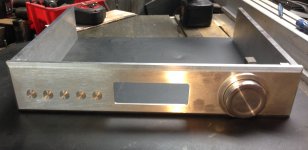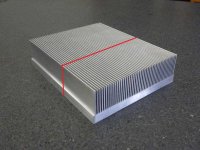Pass DIY Addict
Joined 2000
Paid Member
Thanks... but.... 🙂
I'm probably one of the worst 'machinists' on the globe. Most everything I make ends up smaller than intended because I have to keep trying
Still, for me half the fun of DIYA is making the chassis, and using scrap doubles the challenge!
I'm probably one of the worst 'machinists' on the globe. Most everything I make ends up smaller than intended because I have to keep trying

Still, for me half the fun of DIYA is making the chassis, and using scrap doubles the challenge!
Last edited:
Very nice, I am from India looking out for 400mm length * 200mm width heatsinks can someone guide me on getting one ?
diyAudiostore.com has 200mmx210mm heatsinks. You can put two of them side by side for 400mm length.
40mm Heatsinks – diyAudio Store
40mm Heatsinks – diyAudio Store
Pass DIY Addict
Joined 2000
Paid Member
damn! I've cut trice and it's always short!
Ha - come up with a way to cut something and have it be LONGER than what you started with and there a handsome reward (plus an early retirement) in it for you 😀
mpmarino: I presume you do your work on the table saw in your image. What type of blade are you using? I've got a compound mitre saw and a table saw, but have never tried cutting metal with either one.
Eric,
very good quality cuts can be made in aluminum with a high tooth count carbide blade on a compound miter saw. You need to slow the motor speed down for good and safe results. I use a 15 amp Variac to bring the RPM's down low. A variac works well on brushed ac motors like most compound miters saws use.
very good quality cuts can be made in aluminum with a high tooth count carbide blade on a compound miter saw. You need to slow the motor speed down for good and safe results. I use a 15 amp Variac to bring the RPM's down low. A variac works well on brushed ac motors like most compound miters saws use.
Pass DIY Addict
Joined 2000
Paid Member
Ah - this is good advice to have! I did not consider the need to bring the RPMs down while working with metals. Thank you!
I use the tablesaw mostly for a nice flat tabletop since it's usually the only surface not covered with junk. But yea as above you can cut alu on the ts. I use a 60 tooth carbide blade. I don't slow the motor, but I slow the feed rate. Thick aluminum get's multiple passes, raising the blade a bit each time. This can generate a lot of heat.
This is what I do. I do not recommend others do it.
It can be dangerous if things go sideways. I protect myself well. It doesn't generate sawdust, but flying alu chips that always want to hit your face, and sting your arms.
But otherwise I have an ancient southbend lathe and a '70s import bridgeport copy. Both are loose enough to drive me insane 🙂
This is what I do. I do not recommend others do it.
It can be dangerous if things go sideways. I protect myself well. It doesn't generate sawdust, but flying alu chips that always want to hit your face, and sting your arms.
But otherwise I have an ancient southbend lathe and a '70s import bridgeport copy. Both are loose enough to drive me insane 🙂
Get the highest tooth count you can find. I use an 80 tooth carbide on my table saw at full speed for alu.
And yes, the chips are hot and they sting. 😉
And yes, the chips are hot and they sting. 😉
Guys,
Understand we are getting a bit OT on the thread, but since a discussion is going on around cutting aluminum, can anybody advise a good way to cut a heat sink across the fins? Picture below - cut would be following the red line.
TIA.
Understand we are getting a bit OT on the thread, but since a discussion is going on around cutting aluminum, can anybody advise a good way to cut a heat sink across the fins? Picture below - cut would be following the red line.
TIA.
Attachments
Get the highest tooth count you can find. I use an 80 tooth carbide on my table saw at full speed for alu.
And yes, the chips are hot and they sting. 😉
you might be correct- I'm probably using an 80 as well. Bad memory.
Table (circular saw) works fine too. I'd strongly recommend using some kind of cutting fluid (i've used sewing machine oil, but I believe the best practice for aluminium is wax, and you don;t need heaps, just get a thin layer on the job), and the highest tooth count you can.
I'd also say, go slowly! I've (unthinkingly) started pushing the job through at a hardwood sort of pace, and had the ally bend and not be cut. The noise was loud, and scared the absolute bejeebers out of me.
I'd also suggest you stand clear of where the job might go should something untoward occur; ie do not stand directly behind it in case it gets spat off the saw at a high speed...
And finally, make sure to cleanup afterwards asap. Oily little chips of ally get absolutely everywhere, and will mess up your clothes, carpets etc etc
I'd also say, go slowly! I've (unthinkingly) started pushing the job through at a hardwood sort of pace, and had the ally bend and not be cut. The noise was loud, and scared the absolute bejeebers out of me.
I'd also suggest you stand clear of where the job might go should something untoward occur; ie do not stand directly behind it in case it gets spat off the saw at a high speed...
And finally, make sure to cleanup afterwards asap. Oily little chips of ally get absolutely everywhere, and will mess up your clothes, carpets etc etc
- Home
- Amplifiers
- Pass Labs
- Pictures of your diy Pass amplifier

